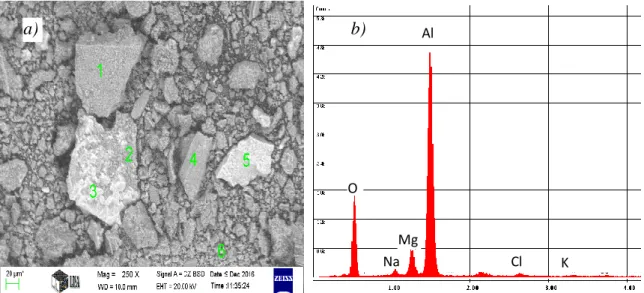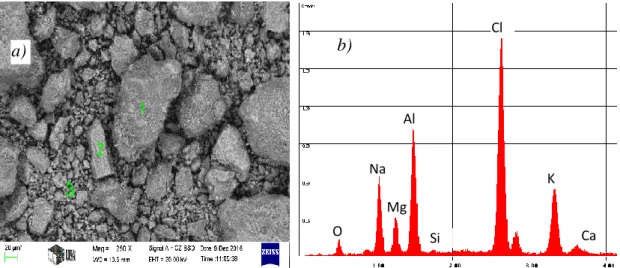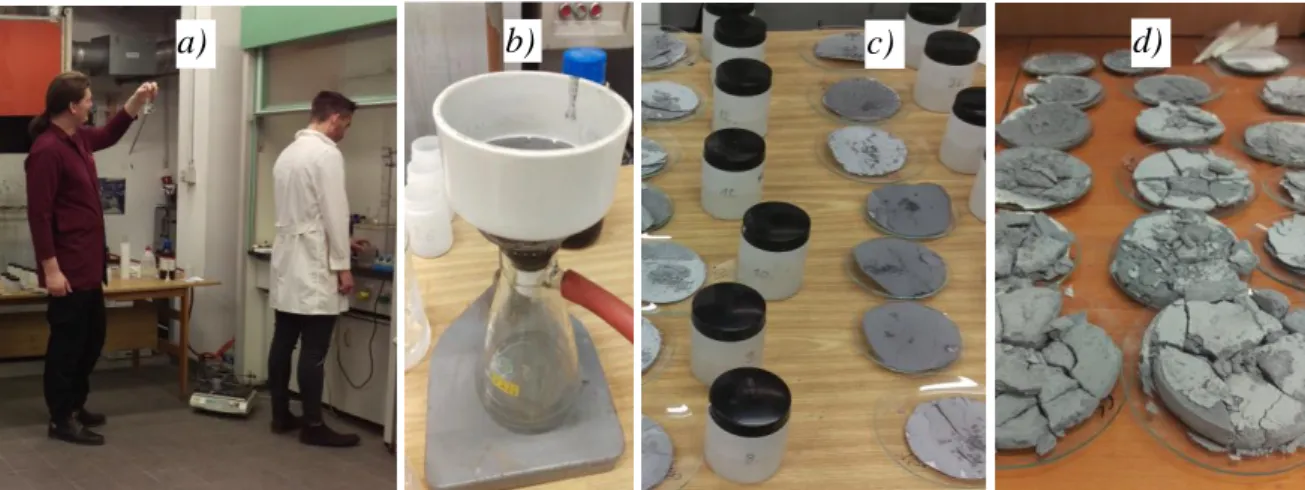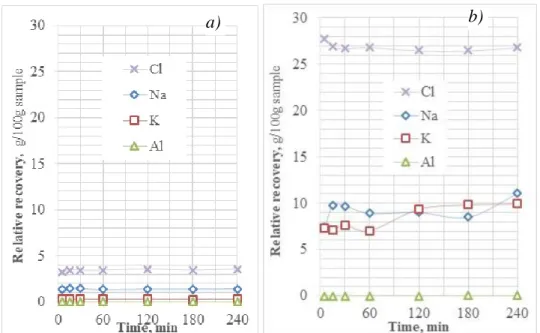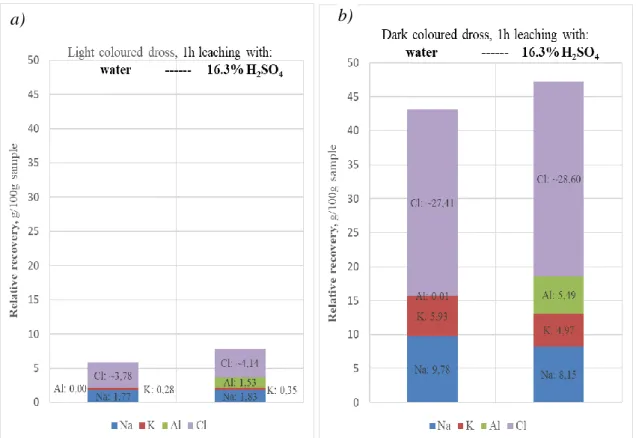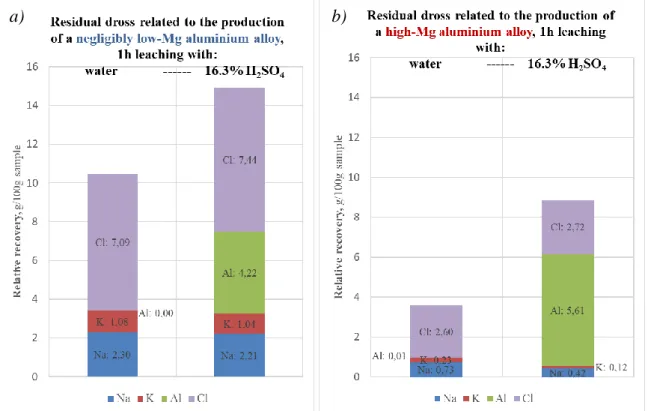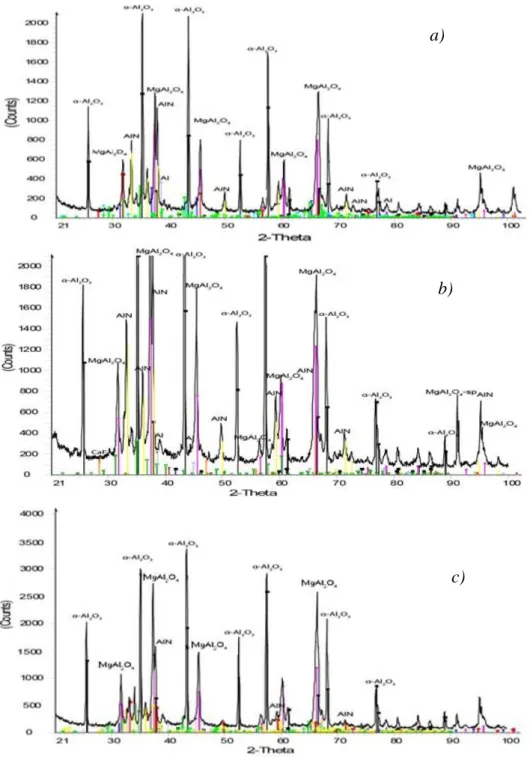LEACHING BEHAVIOUR OF THE RESIDUE FROM THE THERMO-MECHANICAL TREATMENT OF ALUMINIUM
MELTING DROSS
Balázs Hegedüs1, Tamás Kékesi2
1 MSc student, 2 Professor
Institute of Energy and Quality, University of Miskolc, Hungary, kekesi@uni-miskolc.hu
ABSTRACT
A large amount of currently useless basically oxide residue is produced by the treatment of dross obtained from the melting of alloyed aluminium scrap. Its negligible residual metallic component does not make it feasible for any further metallurgical processing. On the other hand, it may have a high content of chloride salts. Its removal may not only serve the purpose of recycling but it may be mandatory to make this residue suitable for applications in preparing construction and road paving materials, or as a slag forming additive in the steel industry. A hydrometallurgical treatment with pure water – after fine grinding – may be efficient in this respect and it may even reduce the residual metallic content if acidic or alkaline media are also used. In order to develop a suitable method of purification, the composition of the raw residue has been examined by SEM and XRD techniques and carried out experiments to determine the efficiencies of the treatments with water, sulphuric acid and sodium hydroxide. The results show that leaching with water can remove the main salt components of NaCl and KCl in a short time. However, the evolution of some NH3 gas from the side reaction of the AlN compound formed during the preliminary thermos-mechanical treatment cannot be avoided. The application of sulphuric acid can be efficient not only in removing the residual metal content but also in suppressing the evolution of NH3. Although the sodium-hydroxide reagent is capable of aggressively dissolve aluminium not only in the metallic but also in the oxidised states, but it may also enhance the evolution of NH3. According to the phase composition and structure of the treated materials, water leaching - perhaps combined with an extra step of sulphuric acid leaching – can be satisfactory for assuring the state of the residual dross to be accepted in non-metallurgical applications.
1. INTRODUCTION
For economic an environmental reasons, the use of secondary raw materials in aluminium production has been continually increasing. The recycling of obsolete products made of aluminium and aluminium based alloys results in an increased generation of dross [1,2], which usually contains a high percentage of the metal [3,4]. This inevitable by- product of melting consists of chains formed by the solid oxide particles. As there is no congruent interface, it may entrap a large amount of liquid metal mechanically [3,4]. Thus it may enhance the heterogeneous oxidation of the aluminium-based melt. The recovery of the high metallic content can be implemented at the production site by a further thermo- mechanical treatment of the hot dross applying heat to melt the entrapped metal and mechanical action combined with salt addition to break the oxide layers insulating the molten droplets. A relatively large amount of usually NaCl-KCl based salt is also added [5], which serves to help separate the oxide coatings and to prevent excessive re-oxidation of the molten metal phase. The metal content of the residual solid waste material discharged after tapping the recovered molten metal from the oxygen-gas fired – usually rotary – “converter” furnace is just a few per cent [6]. Thus it may not be economically MultiScience - XXXII. microCAD International Multidisciplinary Scientific Conference
University of Miskolc, 5-6 September, 2018. ISBN 978-963-358-162-9
DOI: 10.26649/musci.2018.016
2
processed by the usual metallurgical processes. In its usual state, it does not constitute any commercially significant value, rather it may mean a burden both from the financial and environmental aspects. Nevertheless, other industries (such as construction and road paving materials production, cement clinkering, chemical industry, steel making with synthetic slags, mineral wool production, agriculture and glass manufacturing) may use the basically oxide containing residue if the unwanted components, mainly the relatively large amounts of salt [6], can be removed efficiently. The almost negligible portion of dispersed aluminium metal particles are covered by thick and refractory oxide layers, therefore they do not cause much trouble even for the applications in the construction materials industry, but it may even be beneficial when steel making application is proposed.
The salt content – composed of mainly chlorides - of the residual dross can be readily dissolved by pure water at ordinary temperatures, therefore it may be the fundamental and a suitable initial step in a hydrometallurgical processing scheme. The residual dross of high salt content, often referred to as salt cake, is usually black coloured. It is generally crashed and ground. It may be followed by the simple physical removal of the malleable metal grains of larger size, and the fine powder is mixed with as much water to yield a brine liquor of 20 – 25% saturation, which offers efficient dissolution and doesn’t imply excessive energy requirement for the subsequent removal of water by evaporation. As a result of the exothermic reactions of dissolution, the temperature may rise to as high as 60
oC during leaching [6]. The subsequent solid/liquid separation can be carried out in multiple steps, including a preliminary centrifuging to remove the coarser particles. The fine slurry is then settled and washed during filtration. The salt-free solid product can be suitable for the aimed alternative ways of utilization and the brine liquor can be evaporated by boiling, followed by the drying of the wet salt crystals before recycling to the thermal process in the rotary furnace. A perfect recycling of the salt, however, also requires the efficient off gas cleaning and dust precipitation attached to the thermal treatment of the primary dross. As KCl is more volatile than NaCl, the leaching of the latter by-product is also required, and some KCl may still be added to reset the original composition of the usually equi-molar NaCl-KCl mixture used in aluminium melting.
The residual dross obtained from the high temperature treatment of the primary aluminium dross contains nitrides and carbides too. These compounds may also react with water during leaching:
AlN + 3H2O = Al(OH)3 + NH3 (1)
AlN + 4H2O = Al(OH)3 + NH4OH (2)
AlN + NaOH +H2O = NaAlO2 + NH3 (3)
Al4C3 + 12H2O = 4Al(OH)3 + 3CH4 (4)
The fine metallic particles – after the oxide coating is removed – may react with the alkaline or acidic or even the neutral aqueous medium, like: Al +NaOH + H2O = NaAlO2 + 1.5H2 (5)
Al +3NaOH = Na3AlO3 + 1.5H2 (6)
Some other dangerous gases (phosphine, hydrogen sulphide) may also be evolved. These reactions are all exothermic, and the co-existence of heat and the inflammable gases may even cause danger of fire and explosion besides poisoning. However, these effects may also be present when the residual dross is simply disposed of. There are proposed technologies [7] which are assumed to offer 99% recovery of the salt and a low (<0,2 %) chloride content in the final residue, and the harmful gases evolved during the hydrometallurgical treatment are combusted. The heat from the latter step can be utilized for the evaporation of water.
3 EXPERIMENTAL PROCEDURE
As a result of the thermo-mechanical treatment of the aluminium melting dross, solid residues of different colour can be obtained. In the extreme cases they can appear light or dark, as shown in Fig. 1. The metallic content of the lighter material is lower. In the obtained sample it was 9.9%, and it was a mere 1.1 per cent in the fine (< 250 µm) fraction obtained after grinding. Whereas these values were 13.6 and 4.5 per cent in the dark material representing the opposite extreme quality. The metallic content in the powder fraction was finely dispersed and in particles covered by a thick oxide layer. This part of the metal content in the residual dross could be determined only by the volume of the collected hydrogen gas evolved from the reaction of aluminium with hot and concentrated NaOH solution [3,4].
Fig. 1 The macro images of the light (a) and dark (b) coloured residues from the thermal treatment.
2.1. The examined material
The major constituent of the two different looking types of the residual dross – serving as the principal raw materials for the experiments – were examined by scanning electron microscopic (SEM), energy dispersive X-ray microprobe (EDS) and X-ray dispersive (XRD) techniques applying the finely ground (< 250 µm) fractions. The characteristic micro images and the relevant EDS spectra are shown in Fig. 2 and 3.
.
Fig. 2 The SEM image (a) and the EDS spectrum (b) of the light coloured residue from the thermo-mechanical treatment.
a) b)
a) b)
O
Na Mg
Al
Cl K
4
Fig. 3 The SEM image (a) and the EDS spectrum (b) of the dark coloured residue from the thermo-mechanical treatment.
As the electron beam can penetrate into the oxide material to a depth of ~ 5 µm, the core of the grains may also contribute to the spectra if the oxide coating is thinner. besides, the X-ray emission of the larger atoms is relatively stronger, thus the Al signal is stronger than those of Na, Mg or O even at practically equal concentrations. On the other hand, the signals of Cl and Ca are relatively stronger. The EDS spectra reveal that the light coloured dross residue mainly consists of aluminium oxide, while the dark coloured residue exhibits a relatively large proportion of the salt components and probably more metallic aluminium.
A similar examination of the additive salt pointed out NaCl and KCl as the main components and some added CaF2. The phase composition of the examined residual dross materials are given by the obtained XRD spectra in Fig. 4.
Fig. 4 The XRD spectra of the light (a) and dark (b) dross residues.
a) b)
a)
b)
O Na
Mg Al
Cl
K
Si Ca
5
The XRD spectra have proved that the simple and complex oxides (α-Al2O3 és a MgAl2O4
spinel) dominate in the light coloured dross residue, and the remaining salt is indicated mostly by the presence of NaCl and KCl. The high temperature treatment could cause the formation of AlN, clearly detected in this sample. However, the remaining salt content is significantly higher in the dark dross residue and the Mg-spinel component is also more evident. The dominance of the simple oxides in the light coloured dross residue indicates the higher temperature probably reached during the thermo-mechanical treatment, which also enhances the evaporation of especially KCl and Mg.
2.2. Leaching experiments
The finely ground light and dark coloured dross residue samples - obtained from the industrial thermo-mechanical processing of aluminium melting dross - were leached with distilled water, 16.3 m/m % (10 V/V %) sulphuric acid and 6 mol/dm3 NaOH solutions.
The selected H2SO4 concentration corresponds to the medium high level, preferred generally in hydrometallurgy [8-10], and the high NaOH concentration served as a reference to the strong solubilizing effect for Al2O3 [4]. Further experiments were carried out with dross residues from laboratory scale thermo-mechanical treatment of dross samples obtained from the industrial melting of aluminium scrap alloyed with magnesium to yield different grades. The pulverised solid samples were always contacted with 100 cm3 of the lixiviant solutions, which proportion could safely provide solubility. The suitable kinetic conditions were assured by horizontal shaking of sufficient intensity to eliminate the settling of the dross particles in polyethylene reactor vessels of 300 cm3 volume. The leaching experiments were carried out each for 5, 15, 30, 60, 120, 180 and 240 minutes.
The progress of dissolution was indicated by the analysis of the filtered solution samples.
The concentrations of the chloride and the hydrogen ions were obtained by titrimetric methods, but the concentrations of the dissolved metals were determined by atomic absorption spectrometry (AAS). The results were expressed as recoveries relative to the mass of the examined dross samples. The equipment and the steps of laboratory leaching experiments are illustrated by Fig. 5.
Fig. 5 The fundamental leaching experiments – (a)leaching and sample preparation, (b) vacuum filtering, (c,d) solutions and solid residues from leaching.
2. EXPERIMENTAL RESULTS AND DISCUSSION
The recoveries of the elements dissolved by water from the light and dark coloured residual dross samples obtained from the industrial thermo-mechanical treatment are given in Fig. 6.
a) b) c) d)
6
Fig. 6 The relative recoveries by water leaching from (a) the light and (b) dark coloured dross samples obtained from the industrial thermo-mechanical treatment.
The recovery of chlorine – despite the probable errors of the argentometric analysis attributable to the continually decreasing strength of the AgNO3 test solution – directly demonstrates the high soluble salt content of the dark dross sample. According to the more accurate AAS analysis, the leaching with water could reach a salt recovery of 35.9 % relative to the sample mass of the dark residual dross, which was 48.7 % according to the argentometric titration. On the other hand, water leaching of the light coloured dross material yielded only 5 % salt recovery by AAS and 6.4% by the less reliable argentometry. This is a considerable difference. It is also remarkable, how quickly the water leaching of the chloride salt – obviously within a few minutes - can be completed.
Applying sulphuric acid had a great effect on the removal of the aluminium content, as it is shown by the diagrams in Fig. 7.
Fig. 7 The relative recoveries by 16.3% H2SO4 leaching from (a) the light and (b) dark coloured dross samples obtained from the industrial thermo-mechanical treatment.
a) b)
a) b)
7
Based on the AAS analytical results for Na and K, the acid leaching of the dark residual dross gave ~ 40.4 % chloride salt recovery relative to the sample mass. This is ~ 5% lower than that obtained with pure water. At the same time, the argentometric analysis shows a chloride salt recovery of 51.7 % from the dark residual dross. In the acidic medium, however, the potassium chromate indicator may be converted in larger proportions to the inert H2CrO4 form. A noticeable - and expected - change as a result of applying then 16.3%
sulphuric acid solution is the recovery aluminium of ~ 6 % from the dark sample, which was only 1.5% in the case of the light coloured dross. It corresponds to the assumption that the dross may have received a more aggressive thermal treatment which resulted in a consequently more intensive oxidation, leaving less soluble aluminium in the residual dross. The kinetic curves suggest that the dissolution of aluminium by the acid leaching is completed within 60 minutes, while the salt content is dissolved in less than 15 minutes.
The relative recoveries obtained by water and sulphuric acid in leaching experiments lasting uniformly for 60 minutes are compared in Fig. 8.
Fig. 8 The relative recoveries by water (left bar) and 16.3% H2SO4 (right bar) leaching from the light (a) and dark (b) coloured finely ground (<250 µm) dross samples obtained
from the industrial thermo-mechanical treatment.
The one hour leaching tests could reflect the total amounts of the dissolved components.
Confirming the results of the kinetic study presented in Figs. 6 and 7, these results also show that the salt content of the dark coloured residual dross is more than ~5 times higher than that of the light coloured one. However, this ratio is significantly greater for KCl, which is prone to preferential vaporization during high temperatures. It proves the more aggressive thermal conditions in the case of the preliminary thermos-mechanical treatment producing the light coloured residual dross. The same is the reason for the difference in the dissolved Na/K molar ratios for the two different types of the residual dross (~ 1.7 in the case of the dark and ~ 9.3 in the case of the light coloured dross).
a) b)
8
Further experiments examined the leaching behaviour of residual dross samples obtained by laboratory scale thermo-mechanical treatment [3,4] of primary melting dross materials originating from the melting of aluminium alloy scrap of negligibly low and high Mg contents, respectively. The results referring to the 1 hour treatment of these samples with either water or 16. 3 % sulphuric acid are shown in Fig. 9.
Fig. 9 The relative recoveries by water (left bar) and 16.3% H2SO4 (right bar) leaching from the residual dross related to the production of low-Mg and (a) and high-Mg (b) finely
ground (<250 µm) dross samples obtained from the industrial thermo-mechanical treatment.
Again, a great difference is seen in the case of the dissolved chloride salts, although they were added at the same rate to both charges. It shows that a higher loss by evaporation could happen in the thermo-mechanical treatment of the primary dross containing high-Mg aluminium alloy as the entrained metal. The ratio of the more volatile KCl component to NaCl is again lower in this case, also indicating the higher temperatures reached. These conditions do not reduce the relative amount of the Al metal dissolved by the acid leaching step, showing that the thermo-mechanical treatment in the induction-type laboratory furnace did not entail higher degree of re-oxidation even at higher temperatures.
The compositions of the solid residues obtained after the 1 hour leaching experiments were examined – after drying at 105 oC – by similar instrumental techniques as applied for the raw materials and shown in Section 2.1. The SEM images showed wrinkled surfaces of particles consisting of Al and O, indicating the presence of α-Al2O3, and the Na, K and Cl peaks disappeared from the EDS spectra, confirming the removal of the salt content both by the water and the acid or the also examined NaOH leaching procedures.
The remaining phases could be detected by the XRD analysis, providing important information on the applicability of the leached material for the alternative purposes proposed in Chapter 1. The constituting phases detected after the leaching of the light coloured dross residue with water, sulphuric acid and – for reference – with NaOH are marked on the XRD spectra of Fig. 10.
a) b)
9
Fig. 10 The XRD spectra of the solid residues of the light coloured finely ground (<250 µm) dross samples obtained from the industrial thermo-mechanical treatment after 1 hour
of leaching with water (a), 16.3% H2SO4 (b) and 6M NaOH (c).
As the water leaching removed the chloride salts, the α-Al2O3 has become dominant, but the presence of MgAl2O4 spinel is also evident in the solid residue of the light coloured residual dross. The diffractogram obtained after the sulphuric acid leaching is similar, but the spinel seems to be present at a higher proportion. It refers to the high chemical stability of the MgAl2O4 compound, which may render it even more resistant against the acid than α-Al2O3. At the same time the intensity of the AlN peaks are slightly higher when the acid was used instead of water for leaching. It shows that the unpleasant evolution of NH3 may be slightly depressed by the addition of sulphuric acid in the water for leaching the residual dross obtained from the high temperature thermo-mechanical treatment of the primary dross. The remaining – slight – metallic Al content is hidden under the thick oxide cover,
a)
b)
c)
10
which cannot be detected by the X-ray beam of the XRD or the electron beam of the SEM or techniques. The leaching with the aggressive 6M NaOH solution could more efficiently release and dissolve virtually all the metallic Al, but it also involved a strong evolution of gas and heat. This is caused by the dissolution of Al, producing H2 and the reaction of AlN with water, enhanced by NaOH according to Eq. (3), generating of NH3. The intensity of this reaction is proved as the AlN XRD peaks are removed after the NaOH leaching.
Because of the higher initial concentration of the salt components, the effects of leaching can be even more clearly demonstrated by the solid residues from the hydrometallurgical treatment of the dark coloured residual dross obtained from the industrial thermo-mechanical processing. The relevant XRD spectra can be seen in Fig. 11.
Fig. 11 The XRD spectra of the solid residues of the dark coloured finely ground (<250 µm) dross samples obtained from the industrial thermo-mechanical treatment after 1 hour
of leaching with water (a), 16.3% H2SO4 (b) and 6M NaOH (c).
a)
b)
c)
11
Mainly the spinel MgAl2O4 and the α-Al2O3 compounds and the metallic Al could remain beside the relatively lower AlN content in the solid residue after water leaching the dark coloured residual dross obtained from the industrial thermo-chemical treatment of the primary aluminium dross. As the salt content is efficiently removed, the dominance of the spinel component becomes evident, but here also the metallic Al is clearly detected. These characteristics are different from the previous case. Due to the probably milder thermal conditions during the preliminary thermo-mechanical processing at the industrial plant, the evaporation of Mg metal and the salt components could be less intensive, and the former could extensively form spinel compounds. The greater salt content could enhance the coalescence of aluminium droplets, which resulted in a decrease of secondary oxidation and cleaner surface of the appearing metallic particles. The relatively higher diffraction peaks of AlN can be seen after the sulphuric acid leaching, indicating again the repression of the harmful reaction (2) by the acidic medium. The metallic Al was already missing from the XRD spectrum obtained from the residue after the acid leaching. The only remaining salt component was the small amounts of the additive CaF2, which is not dissolved either in water nor in the alkaline solution. Experience has shown, that it may be gradually converted to the sulphate by applying sulphuric acid, but a relatively slight dissolution of Ca may be noticed only during a subsequent water rinsing.
4. CONCLUSIONS
The hydrometallurgical treatment – by leaching with water, sulphuric acid or sodium hydroxide solutions – can cause significant changes in the composition and structure of the residual dross obtained from the thermo-mechanical processing of the primary dross generated in the melting procedure of alloyed aluminium scrap. It is confirmed that water leaching is efficient and quick in removing the chloride salt content. NaCl and KCl are dissolved within a few minutes almost completely. However, the reaction of AlN – generated at the high temperature pre-treatment of the dross – with water may occur simultaneously. The latter reaction causes the evolution of some harmful NH3 gas too. Its absorption or collection and combustion should be coupled with any implementation of the aqueous processing of the dross.
The chloride salts can also be efficiently removed by dilute acid or the concentrated alkaline solutions. Either H2SO4 or NaOH solutions are efficient in dissolving also the remaining metal content in the treated dross, however this process is slower. The reaction of AlN and the generation of NH3 is repressed by the acid, but strongly intensified by NaOH in the solution, however the CaF2 content is not solubilized by the latter agent. A noticeable conversion and slight dissolution of the latter compound may be caused by the application of sulphuric acid.
According to the phase analysis of the solid residues, water leaching may be sufficient if only the removal - or recycling - of the easily soluble chloride salts is intended. If the relatively low concentration of the remaining metal – dispersed in small particles covered by thick oxide layers – is also required, a second step of leaching with dilute sulphuric acid needs to be included. The leaching procedure produces a strong salt solution, which may be evaporated to recover the salt, and a solid residue which may be utilized for different industrial technologies as a raw or an additive material. Its metal content is almost inactive in most of the conditions, or can be removed by acid leaching, but it may even be beneficial in such applications as steel making additive.
12 ACKNOWLEDGEMENT
The research was carried out in the Centre of Applied Materials Science and Nano- Technology at the University of Miskolc. The continuation is supported by the GINOP- 2.2.1-15-2016-00018 project in the framework of the New Széchenyi Plan of Hungary, co- financed by the European Social Fund. The described study was carried out as part of the EFOP-3.6.1-16-2016-00011 “Younger and Renewing University – Innovative Knowledge City – institutional development of the University of Miskolc aiming at intelligent specialisation” project implemented in the framework of the Széchenyi 2020 program. The realization of this project is supported by the European Union, co-financed by the European Social Fund.
REFERENCES
[1] Han, Q., et al.: Dross formation during remelting of aluminium 5182 remelt secondary ingot (RSI), Materials Sci. Eng. A363 (2003) 9-14.
[2] Krone, K.: Aluminium Recycling, VDS, Düsseldorf, 2000.
[3] Tóth, G.B., Harangi, Z., Kulcsár, T., Kékesi, T.: Metal content of drosses arising from the melting of aluminium XXVII microCAD International Scientific Conference, Miskolc, Hungary, 21-22 March 2013, Section C-D/14, p12.
[4] Kulcsár, T., Kékesi, T.: Thermo-mechanical extraction of aluminium from the dross of melting Al and AlMg scrap. MultiScience – XXXI. microCAD International Multidisciplinary Scientific Conference, Miskolc, Hungary, 20-21 April 2017, Section B/13, p9.
[5] Ho, F.K., Sahai, Y.: Interfacial Phenomena in Molten Aluminium and Salt System.
2nd. Int. Symp. Recycling of Metals and Engineered Materials, eds. Van Linden, J.H.L., Stewart, D.L., Sahai, Y.: TMS, Warrendale, 1990, 85-103.4 Ray D. Peterson:
A historical perspective on dross processing, Materials Science Forum Vol 693 (2011) pp 13-23.
[6] Xiao, Y., Reuter, M.A., Boin, U.: Aluminium Recycling and Environmental Issues of Salt Slag Treatment, Journal of Environmental Science and Health, 40:1861–1875, 2005.
[7] http://www.ips-engineering.net/Doc/Engitec/STE%20Process.pdf
[8] Liu, Y, et al.: Study on hydrometallurgical process and kinetics of manganese extraction from low-grade manganese carbonate ores, International Journal of Mining Science and Technology, 24, 4, 2014, 567-571.
[9] Bar, D. L., Barket, D.: The leaching of sulfide iron (II) with sulfuric acid, Journal of Mining Science, 51, 1, 2015, 179 – 185.
[10] Gilchrist, J.D.: Extraction Metallurgy, Elsevier; 2Rev Ed., 1979.
